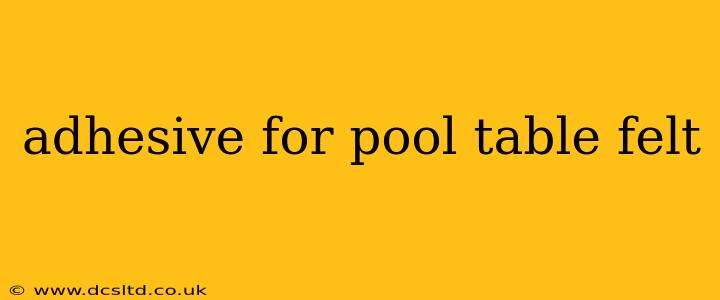Replacing your pool table felt can dramatically improve your game, restoring a smooth, consistent playing surface. But choosing the right adhesive is crucial for a long-lasting, professional-looking result. This guide delves into the best adhesives for pool table felt, addressing common concerns and ensuring a flawless installation.
What Type of Adhesive is Best for Pool Table Felt?
The best adhesive for pool table felt is a contact cement. This type of adhesive offers a strong, permanent bond that's essential for withstanding the wear and tear of regular gameplay. Avoid using water-based glues or spray adhesives, as these are not durable enough for this application. Look for contact cement specifically designed for fabrics and upholstery, as these formulations are less likely to damage the felt or bleed through.
What are the Different Types of Contact Cement?
While various contact cements exist, some are better suited for pool table felt than others. Key factors to consider include drying time, strength, and ease of cleanup. Some popular options include:
- Rubber-based contact cement: Known for its strong bond and flexibility, making it ideal for accommodating the slight movement and stretching of the felt.
- Neoprene-based contact cement: Offers excellent adhesion and water resistance, crucial for protecting the felt from spills and humidity.
It's important to read the manufacturer's instructions carefully, as drying times and application methods can vary.
How Much Adhesive Do I Need for a Pool Table Felt Replacement?
The amount of adhesive needed depends on the size of your pool table. Generally, you'll need enough to apply a thin, even coat to both the table's slate and the felt's underside. It's better to have a little extra than to run short mid-installation. Manufacturers often provide coverage information on their product packaging to help you estimate the quantity needed for your project.
Can I Use Spray Adhesive for Pool Table Felt?
No, spray adhesive is generally not recommended for pool table felt. While it may seem convenient, spray adhesive lacks the holding power and durability of contact cement. The felt may lift or peel over time, especially in high-traffic areas of the table. The investment in quality contact cement is worth it for the longevity and performance of your pool table.
What are Some Other Adhesives to Avoid When Gluing Pool Table Felt?
Beyond spray adhesives, avoid using general-purpose glues, wood glues, or any adhesive not specifically designed for fabric or upholstery. These alternatives might not provide the necessary strength and could damage the felt, the slate, or even leave residue that affects gameplay.
How to Apply Adhesive for Pool Table Felt?
Precise application is vital for a professional finish. Always follow the manufacturer's instructions on the adhesive's packaging for specific application details. Generally, you'll apply a thin, even coat to both surfaces, allow it to dry (according to the instructions), and then carefully press the felt onto the slate, ensuring proper alignment. Using a roller can help remove air bubbles and ensure a firm bond.
What Happens if I Use the Wrong Adhesive?
Using the wrong adhesive can lead to several problems, including:
- Poor adhesion: The felt might lift or peel, causing uneven play and potentially damaging the felt.
- Residue: Some adhesives might leave a sticky residue on the felt, interfering with the ball's roll.
- Felt damage: Incompatible adhesives could damage the felt's fibers, compromising its quality and lifespan.
Choosing the right adhesive is key to a successful pool table felt replacement. By selecting a high-quality contact cement and following application instructions carefully, you can ensure a long-lasting, smooth playing surface for years to come. Remember, investing in the right materials is vital for the longevity and performance of your pool table.
